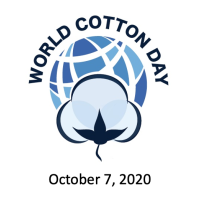
WORLD COTTON DAY – 7 October 2020
HOW WILL BE CELEBRATED THE WORLD COTTON DAY?
Last year the World Trade Organization in collaboration with FAO, UNCTAD, ITC and ICAC announced the day of 7 October – the World Cotton Day.
On 7 October 2020 the cotton community – by numerous local as well as digital activities – is going once again to pay attention of the world to the most known and mostly used , eco-friendly, organic natural fibres – to COTTON!
Due to the pandemics COVID-19, no in-person event for WCD will take place this year like it happened the previous year, when the cotton community celebrated the first time this important day. However particular local and national cotton communities are just preparing meetings, webinars, publications to promote and celebrate the World Cotton Day. The WTO Secretariat appeals to use the hashtag #WorldCottonDay in social media campaigns and publications.
Videos recorded by members and various organisations for WTO Launch of WCD in 2019, as well as other videos will be shown on screens across the building. The International Cotton Advisory Committee (ICAC) will also present information on celebrations on its website. Cotton Associations will underline the importance of the targeting of conducted promotional activities towards final consumers of cotton products, i.e. ALL of US..
The World Cotton Day constitutes an excellent opportunity to remind everybody about the advantages/ of cotton commencing from its wonderful properties as a natural fibre to benefits taken by people thanks to its production, processing, trading and consumption. Furthermore WCD is to shed light on challenges faced globally by the cotton sector, and particularly in the least developed countries .
Why is cotton so important?
- SOCIAL IMPACT single tonne of cotton provides year-round employment for 5 people on average, often in some of the most impoverished regions.
- WATER USAGE Cotton is a drought-resistant crop, with a deep root system ideal for arid climates. Seasonal rainfall at critical points in the plant’s growth is sufficient to produce a high yield.
- LAND USAGE Cotton occupies just 2.1% of the world’s arable land, yet it meets 27% of the world’s textile needs.
- INNOVATION For instance, Cotton-based filaments are appealing to 3D printers because they conduct heat well; become stronger when wet; and are more scalable than materials like wood pulp.
- FIBRE, FOOD AND FEED In addition to its fibre used in textiles and apparel, food products can be derived from Cotton, such as edible oil and animal feed from the seed.
Approximately 150 millions people in about 80 countries make a living from cotton around the world. Small farmers in Africa, China or India, using the latest technologies growers on thousands of hectares in Australia, USA or Brazil along with millions employees of the textile industry, suppliers and transportation companies, designers, fashion houses, retail sales networks, scientific and research institutes as well as universities create the global supply chain linking this sector of the world’s economy.
One of the major characteristics of cotton is its vegetable, natural origin. Consequently cotton is a renewable and furthermore biodegradable within a few months in water as well as in soil. Therefore cotton is the first choice to prevent actively any problems arousing from microplastics. Aa a natural fibre is easy to clean, comfortable to wear and looks nice. It is an ideal material for sustainable clothing and textiles which are produced, used, and at the end of lifecycle – recycled or utilised in any other sustainable way. Moreover, in the contrary to food crops. which have to be promptly sold to keep their market value, cotton has the advantage to be suitable for long storage without losing its quality.
In many regions of the world are conducted various scientific and social projects aimed at improving of the cotton’s quality, implementing of sustainable planting methods as well as its further processing to innovative products. Drones, crop robots, weather and soil sensor techniques connected with computer programmes optimise the process of crops. This is only a small part of technical innovations concerning a modern cotton production..
New applications for cotton constitute a kind of innovations as well.. Apart from main receiver of cotton, i.e. the textile industry, it is also used in the pulp and paper industry, for a production of biocompostes, and an edible oil is produced from cotton’s seeds, biofuel or an additive to cattle feed, and vegetable leftovers are applied as natural fertilizer.
Tell us your “cotton story” and … Happy World Cotton Day!

